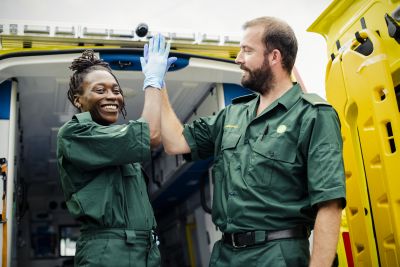Pre-hospital professionals such as emergency physicians or paramedics must be able to choose and adequately don and doff personal protective equipment (PPE) in order to avoid COVID-19 infection. Suppan, et al. (2020) sought to evaluate the impact of a gamified e-learning module on adequacy of PPE in student paramedics.
This was a web-based, randomized 1:1, parallel-group, triple-blind controlled trial. Student paramedics from three Swiss schools were invited to participate. They were informed they would be presented with both an e-learning module and an abridged version of the current regional prehospital COVID-19 guidelines, albeit not in which order. After a set of 22 questions designed to assess baseline knowledge, the control group was shown the guidelines before answering a set of 14 post-intervention questions. The e-learning group was shown the gamified e-learning module right after the guidelines, and before answering post-intervention questions. The primary outcome was the difference in the percentage of adequate choices of PPE before and after the intervention.
The participation rate was of 71% (98/138). A total of 90 answer sets was analyzed. Adequate choice of PPE increased significantly both in the control (50% [33;83] vs 25% [25;50], P = .013) and in the e-learning group (67% [50;83] vs 25% [25;50], P = .001) following the intervention. Though the median of the difference was higher in the e-learning group, there was no statistically significant superiority over the control (33% [0;58] vs 17% [− 17;42], P = .087). The e-learning module was of greatest benefit in the subgroup of student paramedics who were actively working in an ambulance company (42% [8;58] vs 25% [− 17;42], P = 0.021). There was no significant effect in student paramedics who were not actively working in an ambulance service (0% [− 25;33] vs 17% [− 8;50], P = .584).
The researchers conclude that the use of a gamified e-learning module increases the rate of adequate choice of PPE only among student paramedics actively working in an ambulance service. In this subgroup, combining this teaching modality with other interventions might help spare PPE and efficiently protect against COVID-19 infection.
Reference: Suppan L, Stuby L, et al. Impact of an e-learning module on personal protective equipment knowledge in student paramedics: a randomized controlled trial. Antimicrobial Resistance & Infection Control. Vol. 9, No. 185. 2020.

Be the first to comment on "Researchers Examine Use of PPE Among Paramedics During COVID-19"